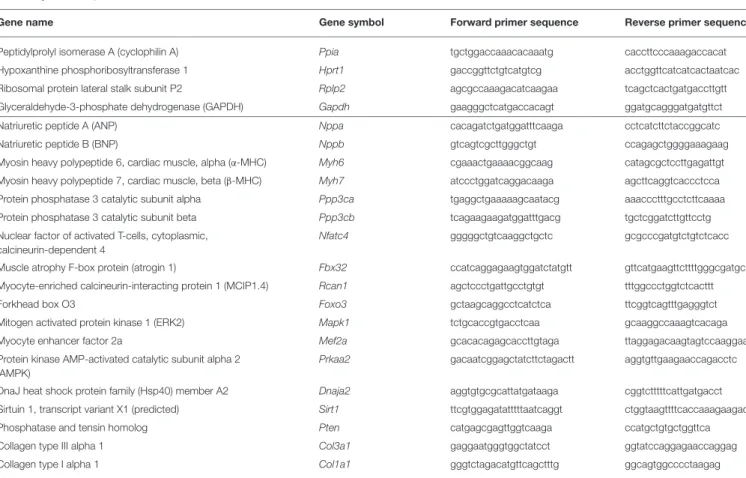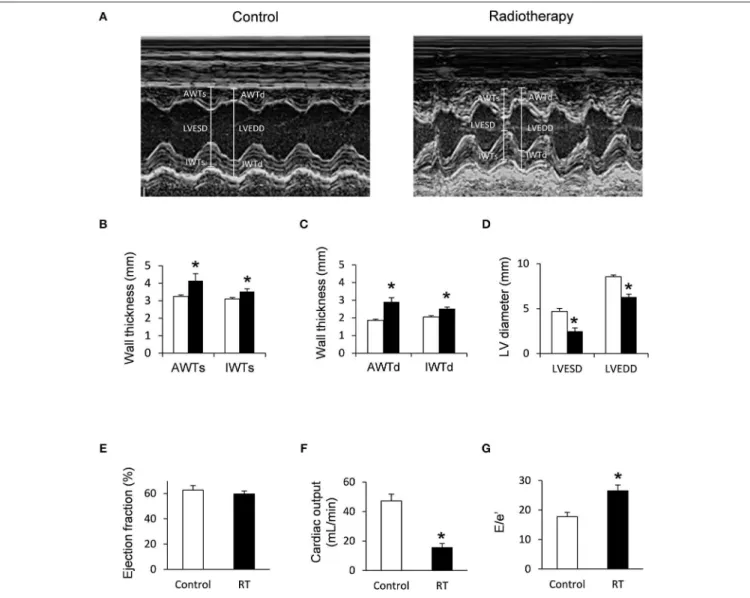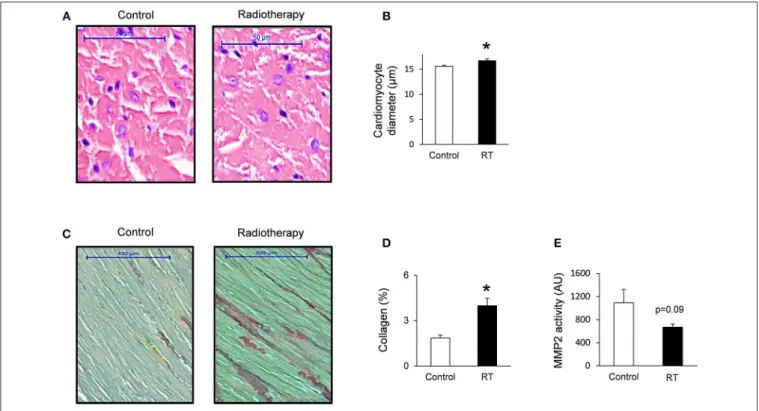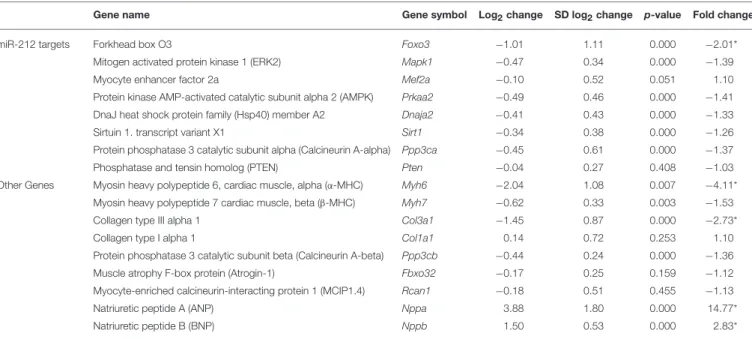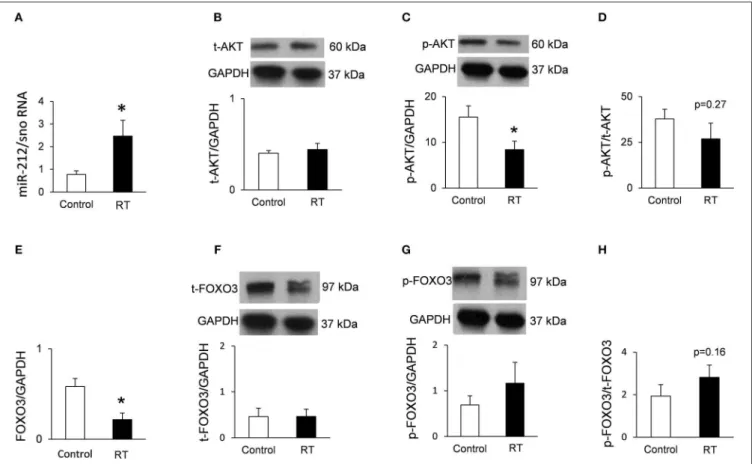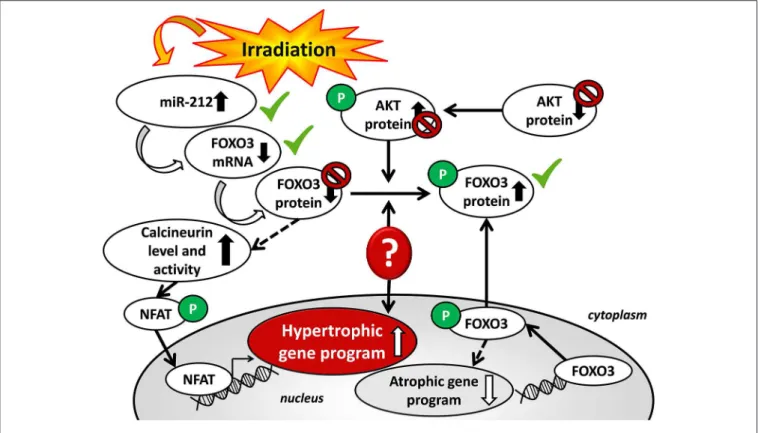doi: 10.3389/fonc.2019.00598
Edited by:
Timothy James Kinsella, Warren Alpert Medical School of Brown University, United States Reviewed by:
Michael Wayne Epperly, University of Pittsburgh, United States Heng-Hong Li, Georgetown University, United States
*Correspondence:
Márta Sárközy sarkozy.marta@med.u-szeged.hu
Specialty section:
This article was submitted to Radiation Oncology, a section of the journal Frontiers in Oncology Received:30 January 2019 Accepted:17 June 2019 Published:16 July 2019 Citation:
Sárközy M, Gáspár R, Zvara Á, Kiscsatári L, Varga Z, K ˝ovári B, Kovács MG, Sz ˝ucs G, Fábián G, Diószegi P, Cserni G, Puskás LG, Thum T, Kahán Z, Csont T and Bátkai S (2019) Selective Heart Irradiation Induces Cardiac Overexpression of the Pro-hypertrophic miR-212.
Front. Oncol. 9:598.
doi: 10.3389/fonc.2019.00598
Selective Heart Irradiation Induces Cardiac Overexpression of the
Pro-hypertrophic miR-212
Márta Sárközy1*, Renáta Gáspár1, Ágnes Zvara2, Laura Kiscsatári3, Zoltán Varga3, Bence K ˝ovári4, Mónika G. Kovács1, Gerg ˝o Sz ˝ucs1, Gabriella Fábián3, Petra Diószegi1, Gábor Cserni4, László G. Puskás2, Thomas Thum5, Zsuzsanna Kahán3, Tamás Csont1and Sándor Bátkai5
1Metabolic Diseases and Cell Signaling Group, Department of Biochemistry, Interdisciplinary Centre of Excellence, University of Szeged, Szeged, Hungary,2Laboratory for Functional Genomics, Biological Research Center of the Hungarian Academy of Sciences, Institute of Genetics, Szeged, Hungary,3Department of Oncotherapy, Faculty of Medicine, University of Szeged, Szeged, Hungary,4Department of Pathology, University of Szeged, Szeged, Hungary,5Institute of Molecular and
Translational Therapeutic Strategies (IMTTS), Hanover Medical School, Hanover, Germany
Background: A deleterious, late-onset side effect of thoracic radiotherapy is the development of radiation-induced heart disease (RIHD). It covers a spectrum of cardiac pathology including also heart failure with preserved ejection fraction (HFpEF) characterized by left ventricular hypertrophy (LVH) and diastolic dysfunction.
MicroRNA-212 (miR-212) is a crucial regulator of pathologic LVH via FOXO3-mediated pathways in pressure-overload-induced heart failure. We aimed to investigate whether miR-212 and its selected hypertrophy-associated targets play a role in the development of RIHD.
Methods: RIHD was induced by selective heart irradiation (50 Gy) in a clinically relevant rat model. One, three, and nineteen weeks after selective heart irradiation, transthoracic echocardiography was performed to monitor cardiac morphology and function. Cardiomyocyte hypertrophy and fibrosis were assessed by histology at week 19. qRT-PCR was performed to measure the gene expression changes of miR-212 and forkhead box O3 (FOXO3) in all follow-up time points. The cardiac transcript level of other selected hypertrophy-associated targets of miR-212 including extracellular signal-regulated kinase 2 (ERK2), myocyte enhancer factor 2a (MEF2a), AMP-activated protein kinase, (AMPK), heat shock protein 40 (HSP40), sirtuin 1, (SIRT1), calcineurin A-alpha and phosphatase and tensin homolog (PTEN) were also measured at week 19.
Cardiac expression of FOXO3 and phospho-FOXO3 were investigated at the protein level by Western blot at week 19.
Results: In RIHD, diastolic dysfunction was present at every time point. Septal hypertrophy developed at week 3 and a marked LVH with interstitial fibrosis developed at week 19 in the irradiated hearts. In RIHD, cardiac miR-212 was overexpressed at week 3 and 19, and FOXO3 was repressed at the mRNA level only at week 19. In contrast, the total FOXO3 protein level failed to decrease in response to heart irradiation at week 19.
Other selected hypertrophy-associated target genes failed to change at the mRNA level in RIHD at week 19.
Conclusions: LVH in RIHD was associated with cardiac overexpression of miR-212. However, miR-212 seems to play a role in the development of LVH via FOXO3-independent mechanisms in RIHD. As a central regulator of pathologic remodeling, miR-212 might become a novel target for RIHD-induced LVH and heart failure.
Keywords: thoracic irradiation, left ventricular hypertrophy, heart failure with preserved ejection fraction (HFpEF), miRNA-212, FOXO3
INTRODUCTION
Radiotherapy has an important role, among other therapeutic modalities, in the treatment of thoracic tumors including breast, lung, esophageal and childhood cancers or Hodgkin’s lymphoma.
About half of cancer patients are treated with radiotherapy (1). Although the application of modern radiotherapy planning and delivery techniques significantly improves the radiation protection of the heart, in many cases, the whole heart, or part of it, still receives a dose sufficient enough to cause radiation- induced heart disease (RIHD) with chronic, and often severe consequences (1). RIHD develops many years or decades after radiotherapy in a dose-dependent manner (2, 3). Premature coronary heart disease, electrical conduct defects or valve abnormalities are often associated with RIHD (4–6). In the early phase, RIHD often presents as heart failure with preserved ejection fraction (HFpEF), characterized by LVH and diastolic dysfunction (1,7,8). Radiotherapy significantly improves cancer patient survival; however, in the long-term, patients are at risk of RIHD and subsequent heart failure which becomes a major health issue affecting outcome, quality of life and health care costs (1). Unfortunately, therapeutic options for RIHD are currently insufficient.
Radiation deteriorates the heart structure and function by inducing changes to the vasculature, i.e., coronary arteries and microvessels, and directly acting on the myocardium (9). The focus of the studies so far has been on the vascular effects, which indirectly influence the myocardium (3, 6, 10, 11). Recently, more data has become available on the radiation-induced direct effect on the myocardial structure. Interstitial inflammation and progressive fibrosis are well-known pathological effects of RIHD (12). They have been shown to be mediated by oxidative stress, the activation of pathologic NO-cGMP-PKG signaling, cytokine and growth factor cascades such as IL-4, IL-13, Rho/ROCK pathway and transforming growth factor beta (TGF-β) (1, 7, 9, 13, 14). Histopathological examination of cardiac lesions of RIHD shows hypertrophic cardiomyocytes, inflammatory cells, fibroblasts, and excessive deposition of collagens (1, 7, 14).
Radiation-induced hypertrophy and fibrosis of the myocardium
Abbreviations:AKT, protein kinase B; AMPK, AMP-activated protein kinase;
cGMP, cyclic guanosine monophosphate; ERK2, extracellular signal-regulated kinase 2; FOXO3, forkhead box O3; HFpEF, heart failure with preserved ejection fraction; Hsp, heat shock protein; IL, interleukin; LVH, left ventricular hypertrophy; Mef, myocyte enhancer factor; miR, microRNA; NO, nitric oxide;
PKG, cGMP-dependent protein kinase; PTEN, phosphatase and tensin homolog;
RIHD, radiation-induced heart disease; ROCK, Rho-associated kinase; TAC, transverse aortic constriction; TGF-β, transforming growth factor beta.
ultimately leads to a decrease in elasticity, ductility, and the development of diastolic heart failure. Only a few studies exist so far on the mechanisms of radiation-induced diffuse myocardial injury. The initial phase of RIHD includes reactive cardiac hypertrophy with enlarged cardiomyocytes (1,7,15). Very little is known about the mechanisms of cardiac hypertrophy and the pathological remodeling in RIHD. We have previously developed a clinically relevant rat model of RIHD, characterized by LVH and simultaneous interstitial fibrosis (16). Our present study is based on this RIHD model.
Endogenous microRNAs (miRs, 22 bp) are non-coding RNA species that are post-transcriptional regulators targeting specific mRNAs, resulting in an increase of mRNA degradation via complementary binding and the suppression of protein synthesis, thus influencing cellular function (17). miRs have been described as “master switches” in cardiovascular biology, and the dysregulation of specific miRs are key pathological factors in many cardiovascular diseases (18–21). The miR-212/132 cluster is considered to be a central regulator of the development of pressure-overload-induced LVH and heart failure via the repression of the anti-hypertrophic transcription factor FOXO3 in mice with transverse aortic constriction (TAC) (22). Moreover, the overexpression of miR-212 separate from miR-132, was reported to play a role in the development of LVH and heart failure via fetal gene reprogramming in human hearts (23).
Furthermore, the pro-hypertrophic potential of miR-212 was also confirmed in primary neonatal rat cardiomyocytes (24).
Beyond FOXO3, other predicted or validated LVH-associated direct targets of miR-212 have been identified. They include e.g., the extracellular signal-regulated kinase 2 (ERK2) (25), myocyte enhancer factor 2a (MEF2a) (26); AMP-activated protein kinase (AMPK) (27); heat shock protein 40 (HSP40) (28); sirtuin 1 (SIRT1) (29); calcineurin A-alpha (30); and phosphatase and tensin homolog (PTEN) (31).
So far there is no literature available on cardiac miR-212 and its targets in the development of RIHD. Therefore, we aimed to investigate the potential role of miR-212 and its selected hypertrophy-associated targets in the development of LVH during the early phases of RIHD.
MATERIALS AND METHODS
The datasets generated for this study are available on request from the corresponding author. This study was carried out in accordance with the recommendations of the National Institutes of Health Guide for the Care and Use of Laboratory Animals (NIH Publication No. 85-23, Revised 1996). The protocol was
approved by the Animal Research Ethics Committee of Csongrád County (XV.1181/2013) and the University of Szeged. All institutional and national guidelines for the care and use of laboratory animals were followed.
Animals
A total of 48 male Sprague-Dawley rats (200–220 g, 6–7 weeks old) were used (n = 8 in each group) in three separate experiments. After 1 week of acclimatization in a temperature- controlled room (22 ±2◦C; relative humidity 55±10%), the animals were randomly assigned to different groups. A total of 24 animals received selective heart irradiation to induce RIHD, and a total of 24 animals served as controls. The animals were housed in pairs in individually ventilated cages (Sealsafe IVC system, Italy) in a temperature-controlled room with a 12 h:12 h light/dark cycle. Standard rat chow supplemented with 5% fat (Innovo Kft., Gödöll˝o, Hungary) and tap water were suppliedad libitum(16).
Experimental Setup
Animals were divided into three control and three irradiated groups in separate experiments (n = 8 in each group) (Figure 1). In the irradiated groups, animals received a single dose of 50 Gy delivered to the whole heart to induce RIHD.
Groups were followed-up for 1, 3, and 19 weeks, respectively.
Cardiac morphology and function were assessed by transthoracic echocardiography in all time points. The development of LVH and fibrosis in chronic RIHD was verified by the measurement of myocardial fiber diameters as well as picrosirius red staining for collagen at week 19. Total RNA was isolated from the hearts, and the myocardial expression of miR-212 and its direct target FOXO3 were measured by qRT-PCR in every time point.
Myocardial expression of selected mRNA targets beyond FOXO3 was also measured by qRT-PCR at week 19. Moreover, cardiac expression of total-FOXO3, phospho-FOXO3, total-AKT, and phospho-AKT were measured using Western blot technique at week 19.
Heart Irradiation
Heart irradiation with a single dose of 50 Gy was carried out as described previously (16). Briefly, the planning of the irradiation was based on a 3D model (Figure 1A), and the dose was delivered to the geometric center of the heart. For better coverage of the heart and lung protection, a 6 MeV electron radiation was given with a circle-shaped aperture with a 2 cm diameter (Figure 1B).
The radiation dose was delivered with a Primus linear accelerator (Siemens Healthcare GmbH, Erlangen, Germany) at a dose intensity of 5 Gy/min if the appropriate position of the animal was proven using a built-in electronic portal imaging device (Figure 1C). Before the irradiation, rats were anesthetized with sodium pentobarbital (Euthasol, ip. 40 mg/kg, Produlab Pharma b.v., Raamsdonksveer, The Netherlands), then fixed in the supine position to a flat surface couch.
Transthoracic Echocardiography
Cardiac morphology and function were assessed by transthoracic echocardiography at week 1, 3, and 19 to monitor the development of RIHD (Figure 1D). Rats were anesthetized with
2% isoflurane (Forane, AESICA, Queenborough Limited Kent, UK). Then, the chest was shaved, and the rat was placed in a supine position onto a heating pad. Two-dimensional, M-mode, Doppler, and tissue Doppler echocardiographic examinations were performed in accordance with the criteria of the American Society of Echocardiography with a Vivid 7 Dimension ultrasound system (General Electric Medical Systems) using a phased array 5.5–12 MHz transducer (10S probe) as described previously (16, 32, 33). Data of three consecutive heart cycles were analyzed (EchoPac Dimension software; General Electric Medical Systems) by an experienced investigator in a blinded manner. The mean values of three measurements were calculated and used for statistical evaluation.
Ex vivo Cardiac Perfusions and Tissue Harvesting
The hearts were weighed after 5 min ofex vivoheart perfusion (34–36). Apical and basal parts of the heart were freshly frozen and used for biochemical measurements in every follow-up time point (Figure 1D). A cross-section of the whole heart at the ring of the papillae was cut and fixed in 4% buffered formalin for histological analysis at week 19 (Figure 1D). Following the removal of the heart, the presence of pleural fluid was checked and collected from the chest. Body and lung weights were also measured in every follow-up time point.
Hematoxylin-Eosin Staining
Five-micrometer paraffin-embedded transverse cut sections of the formalin-fixed subvalvular area of the ventricles were stained with hematoxylin-eosin, in the samples collected at week 19.
On these slides, myocardial fiber diameters were measured to verify the development of LVH as described previously (37, 38). Transverse transnuclear widths (cardiomyocyte diameter) were measured of 100 longitudinally oriented, mono-nucleated cardiomyocytes on left ventricle sections cut on the same plane (37,38).
Picrosirius Red Staining and Image Analysis
Five-micrometer paraffin-embedded transverse cut sections of the formalin-fixed subvalvular area of the ventricles were stained with picrosirius red staining in the samples collected at week 19, to assess cardiac fibrosis as described previously [Figure 1D; (16, 38)]. Histological slides were scanned with a Pannoramic P250 scanner (3D-Histech, Budapest, Hungary) and digital images at the magnification of ×40 and ×100 were captured. Medium- size vessels and their perivascular connective tissue sheet, the subepicardial and subendocardial areas were avoided as best as possible. The picrosirius red dyed images were analyzed with an in-house developed program as described previously (16, 38).
This program determines the proportion of red pixels of heart sections using two simple color filters. For each Red-Green-Blue (RGB) pixel, the program calculates the color of the pixel in Hue- Saturation-Luminance (HSL) color space. The first filter is used for detecting red portions of the image. The second filter excludes any white (empty) or light gray (residual dirt on the slide) pixel from further processing using a simple RGB threshold. In this
FIGURE 1 |Experimental protocol figure.(A)3D visualization of the rat heart based on CT scans,(B)positioning of the rat for delivering the radiation dose with a Primus linear accelerator under sodium pentobarbital anesthesia,(C)appropriate position of the animal proven by portal imaging,(D)experimental protocol.
way, the program groups each pixel into one of two sets: pixels considered red and pixels considered green but neither red, nor white, nor gray. Red pixels in the first set correspond to connective tissue and fibrosis. Green pixels in the second set correspond to cardiac muscle. Dividing the number of elements in the first set by the number of elements in both sets gives the proportion of the connective tissue compartment of the heart area examined.
MicroRNA Expression Profiling by qRT-PCR
Quantitative RT-PCR was performed with miR-specific primers to monitor miR expression as described earlier [Figure 1D;
(22, 38)]. In the case of miR-212, RNA was isolated using Trizol reagent (Invitrogen, #15596-018) from heart tissue. For quantitative detection of miR-212, TaqMan MicroRNA Reverse Transcription Kit (Applied Biosystems, #4366597), TaqMan miR-212, and snoRNA (U64702) Assays (Applied Biosystems,
#A25576 and #4427975), and Absolute Blue qPCR Mix
(Abgene, #AB-4136/B) were used according to the manufacturer’s instructions. SnoRNA was used as a control for normalization.
mRNA Expression Profiling by qRT-PCR
Target mRNAs of miR-212 associated with cardiac hypertrophy and heart failure were selected in the TargetScan database.
Quantitative RT-PCR was performed with gene-specific primers to monitor mRNA expression as described previously [Figure 1D; Table 1; (38,39)]. RNA was isolated using Qiagen RNeasy Fibrous Tissue Mini Kit (Qiagen, #74704) from heart tissue. Briefly, 3µg of total RNA was reverse transcribed using High-Capacity cDNA Reverse Transcription Kit (Applied Biosystems, #4368814), specific primers and FastStart Essential DNA Green Master (Roche, #06402712001) were used according to the manufacturer’s instructions. Peptidyl prolyl isomerase A (Ppia), hypoxanthine phosphoribosyltransferase 1 (Hprt1), ribosomal protein lateral stalk subunit P2 (Rplp2), and glyceraldehyde-3-phosphate dehydrogenase (Gapdh) were used as controls for normalization (Table 1).
TABLE 1 |Primer sequences.
Gene name Gene symbol Forward primer sequence Reverse primer sequence
Peptidylprolyl isomerase A (cyclophilin A) Ppia tgctggaccaaacacaaatg caccttcccaaagaccacat
Hypoxanthine phosphoribosyltransferase 1 Hprt1 gaccggttctgtcatgtcg acctggttcatcatcactaatcac
Ribosomal protein lateral stalk subunit P2 Rplp2 agcgccaaagacatcaagaa tcagctcactgatgaccttgtt
Glyceraldehyde-3-phosphate dehydrogenase (GAPDH) Gapdh gaagggctcatgaccacagt ggatgcagggatgatgttct
Natriuretic peptide A (ANP) Nppa cacagatctgatggatttcaaga cctcatcttctaccggcatc
Natriuretic peptide B (BNP) Nppb gtcagtcgcttgggctgt ccagagctggggaaagaag
Myosin heavy polypeptide 6, cardiac muscle, alpha (α-MHC) Myh6 cgaaactgaaaacggcaag catagcgctccttgagattgt Myosin heavy polypeptide 7, cardiac muscle, beta (β-MHC) Myh7 atccctggatcaggacaaga agcttcaggtcaccctcca
Protein phosphatase 3 catalytic subunit alpha Ppp3ca tgaggctgaaaaagcaatacg aaaccctttgcctcttcaaaa
Protein phosphatase 3 catalytic subunit beta Ppp3cb tcagaagaagatggatttgacg tgctcggatcttgttcctg
Nuclear factor of activated T-cells, cytoplasmic, calcineurin-dependent 4
Nfatc4 gggggctgtcaaggctgctc gcgcccgatgtctgtctcacc
Muscle atrophy F-box protein (atrogin 1) Fbx32 ccatcaggagaagtggatctatgtt gttcatgaagttcttttgggcgatgc
Myocyte-enriched calcineurin-interacting protein 1 (MCIP1.4) Rcan1 agctccctgattgcctgtgt tttggccctggtctcacttt
Forkhead box O3 Foxo3 gctaagcaggcctcatctca ttcggtcagtttgagggtct
Mitogen activated protein kinase 1 (ERK2) Mapk1 tctgcaccgtgacctcaa gcaaggccaaagtcacaga
Myocyte enhancer factor 2a Mef2a gcacacagagcaccttgtaga ttaggagacaagtagtccaaggaag
Protein kinase AMP-activated catalytic subunit alpha 2 (AMPK)
Prkaa2 gacaatcggagctatcttctagactt aggtgttgaagaaccagacctc
DnaJ heat shock protein family (Hsp40) member A2 Dnaja2 aggtgtgcgcattatgataaga cggtctttttcattgatgacct
Sirtuin 1, transcript variant X1 (predicted) Sirt1 ttcgtggagatatttttaatcaggt ctggtaagttttcaccaaagaagac
Phosphatase and tensin homolog Pten catgagcgagttggtcaaga ccatgctgtgctggttca
Collagen type III alpha 1 Col3a1 gaggaatgggtggctatcct ggtatccaggagaaccaggag
Collagen type I alpha 1 Col1a1 gggtctagacatgttcagctttg ggcagtggcccctaagag
Matrix Metalloprotease 2 (MMP-2) Zymography
Cardiac MMP-2 activity was measured at week 19 from homogenized samples, to estimate the collagen breakdown in the cardiac extracellular matrix as we described previously (40,41). Briefly, polyacrylamide gels were copolymerized with gelatin, and a 40 µg protein was separated by electrophoresis (150 V, 1.5 h) in each lane. Following electrophoresis, gels were washed with 2.5% Triton X-100 and incubated for 20 h at 37◦C in incubation buffer. Gels were then stained with 0.05% Coomassie Brilliant Blue in a mixture of methanol/acetic acid/water and de-stained in aqueous 4% methanol/8% acetic acid. Zymograms were digitally scanned, and band intensities were quantified using Quantity One software (Bio-Rad, Hercules, CA) (41).
Western Blot
To investigate gene expression changes at protein quantity and activity level, standard Western blot technique was used in case of phospho-AKT, AKT, phospho-FOXO3, and FOXO3 with GAPDH loading background at week 19 [Figure 1D; (38, 42, 43)]. Heart tissue samples (n = 7–8) were homogenized with an ultrasonicator (UP100H Hielscher, Teltow, Germany) in RIPA (Radioimmunoassay) buffer (50 mM Tris–HCl (pH 8.0), 150 mM NaCl, 0.5% sodium deoxycholate, 5 mM EDTA,
0.1% SDS, 1% NP-40 (Cell Signaling, Carlsbad, CA, USA) supplemented with protease inhibitor cocktail and phosphatase inhibitors PMSF and NaF (Sigma, Saint Louis, MO, USA).
The crude homogenates were centrifuged at 15,000 × g for 30 min at4◦C. After quantification of protein concentrations of the supernatants, using the BCA Protein Assay Kit (Pierce, Rockford, IL, USA), 25 µg reduced and denaturated protein was loaded and SDS-PAGE (10% gel, 90 V, 2 h) was performed followed by the transfer of proteins onto a nitrocellulose membrane (20% methanol, 35 V, 2 h). The efficacy of the transfer was checked using Ponceau staining. The membranes were cut horizontally into three parts corresponding to the molecular weights of AKT, FOXO3, and GAPDH. Then the membranes were blocked for 1 h in 5% (w/v) BSA at room temperature and then incubated with primary antibodies (Cell Signaling, Beverly, MA, USA; overnight, 4◦C, 5% BSA) in the concentrations of 1:1,000 against AKT (#9272), phosho- AKT (Ser473, #4060), phospho-FOXO3 (Ser253; #13129), 1:500 against FOXO3 (#2497) or 1:5,000 against GAPDH (#2118 overnight, 4◦C, 1% BSA). Then the membranes were incubated with horseradish peroxidase (HRP)-conjugated goat anti-rabbit secondary antibody 1:2,000 (1:1,000 for FOXO3, 1:5,000 for GAPDH) (Dako Corporation, Santa Barbara, CA, USA; 45 min, room temperature, 1% BSA). After assessment of phosphorylated proteins, the membranes were stripped and reassessed for the total amount of proteins. An enhanced chemiluminescence kit
TABLE2|CharacteristicsoftheRIHDmodelsatweek1,3,and19,respectively. Parameter(unit)Week1Week3Week19 ControlRTp-valueControlRTp-valueControlRTp-value Bodyweightattheendpoint(g)270±9254±80.205394±11#366±10#0.091597±24#425±43#*0.004 Heartweight(g)1.21±0.071.13±0.050.3401.33±0.051.45±0.09#0.2861.74±0.08#1.34±0.06#*0.002 Lungweight(g)1.35±0.061.64±0.07*0.0062.01±0.09#2.72±0.25#*0.0142.29±0.17#2.26±0.18#0.883 Heartweight/bodyweightratio*1,0004.45±0.134.44±0.100.9183.38±0.10#3.99±0.32#0.1002.92±0.09#3.36±0.35#0.239 Valuesaremean±SEM,n=8,*p<0.05vs.control,unpairedt-testwithinthesametimepoints.p-valuesrefertotheunpairedt-testateachtimepoint.#p<0.05vs.week1withinthesamegroup(controlorRT),One-WayANOVA, Bonferronipost-hoctest.RT,radiotherapy.
(Cell Signaling, Carlsbad, CA, USA) was used to develop the membranes. The chemiluminescence signals were analyzed and evaluated by Quantity One Software. Signals of GAPDH and FOXO3, as well as AKT, develop at different time points.
Therefore, the expositions times are different for GAPDH, FOXO3, and AKT. For signal evaluation of Western blots, we always used the non-oversaturated films for correct signal detection (Supplementary Figures).
Statistical Analysis
Statistical analysis was performed using Sigmaplot 12.0 for Windows (Systat Software Inc.). All values are presented as mean ± SEM except the gene expression data measured by qRT-PCR. Data showed normal distribution unless otherwise indicated. Data measured at different follow-up time points in separate experiments including body weight, heart weight, heart weight to body weight ratio, lung weight and echocardiographic parameters were compared using One-Way ANOVA between the groups. A Bonferroni test was used as a post-hoc test. A two sample t-test (in case of the normal distribution of the data) or Mann Whitney U-test (in case of the non-normal distribution of the data) was used to determine the effect of RIHD on all measured parameters within each time point.
P<0.05 was accepted as a statistically significant difference. In the case of target genes, the analysis of relative gene expression data was performed using the 2−11Ctmethod. Gene expression ratios with a p < 0.05 and fold change of <−2.00 or fold change of>2.00 were considered as repression or overexpression respectively in gene activity.
RESULTS
Characteristics of the RIHD Models
At week 1, there was no difference in the body weight between the control and irradiated groups (Table 2). At week 3, the irradiated animals presented a trend toward a lower body weight as compared to the time-matched controls (Table 2). At week 19, the irradiated rats showed significantly lower body weight as compared to the time-matched controls (Table 2). At autopsy at week 1 and 3, there was no pleural fluid in the irradiated animals. At week 19, the presence of extensive pleural fluids was found in almost all animals in the irradiated group (data not shown). At the macroscopic level, no major heart pathologies (including the large vessels, the valves, the coronary arteries, etc.) were observed in the irradiated groups at any follow-up time point. At week 1 and 3, lung weights were significantly increased in the irradiated groups as compared to the time- matched controls (Table 2). A higher lung weight might suggest the presence of acute inflammation and lung edema due to the acute deteriorating effects of ionizing radiation. At week 19, no difference was found in lung weights between the groups (Table 2). At week 1 and 3, there was no difference in heart weights between the irradiated groups and their time-matched controls (Table 2). However, the heart to body weight ratio showed a trend toward an increase in the irradiated group at week 3 (Table 2). The increased heart to body weight ratio might suggest the development of starting cardiac hypertrophy. At week
TABLE3|Effectsofradiotherapyonvariousinvivoleftventricularmorphologicalandfunctionalparametersmeasuredbytransthoracicechocardiographyatweek1,3,and19,respectively. Parameter(unit)View/ModeWeek1Week3Week19 ControlRTp-valueControlRTp-valueControlRTp-value Posteriorwallthickness-systolic(mm)Longaxis/MM2.78±0.122.95±0.110.3072.94±0.113.16±0.120.2143.19±0.16#3.37±0.24#0.526 Posteriorwallthickness-diastolic(mm)Longaxis/MM1.85±0.071.76±0.070.3572.01±0.121.80±0.130.1222.00±0.112.44±0.14#*0.026 Septalwallthickness-systolic(mm)Longaxis/MM2.91±0.133.06±0.080.3493.13±0.083.54±0.13*0.0173.27±0.13#3.71±0.29#0.186 Septalwallthickness-diastolic(mm)Longaxis/MM1.64±0.071.79±0.100.2331.65±0.051.85±0.04*0.0091.87±0.12#2.69±0.34#*0.037 Leftventricularenddiastolicdiameter(mm)Longaxis/MM7.73±0.107.31±0.15*0.0357.99±0.137.63±0.250.2078.55±0.14#6.04±0.52#*0.000 Leftventricularendsystolicdiameter(mm)Longaxis/MM4.45±0.203.76±0.23*0.0484.37±0.163.50±0.26*0.0114.13±0.232.59±0.55#*0.021 Fractionalshortening(%)Longaxis/MM43±348±30.15245±254±3*0.02046±163±6#*0.013 Leftventricularend-diastolicvolume(µl)Fourchamber/2D135±1594±6*0.023120±9114±80.646262±27#91±13*0.000 Leftventricularend-systolicvolume(µl)Fourchamber/2D54±633±3*0.00838±3#37±30.871100±17#36.±5.*0.003 Strokevolume(µl)Fourchamber/2D82±961±50.06482±677±60.676162±14#56±9*0.000 Heartrate(beats/min)Fourchamber/2D349±10373±60.052338±14352±140.488291±7#279±7#0.278 E/e’-wave(m/s)4chamber/PWD13±123±1*0.00215±130±3*0.00017±125±20.004 e’-wave(m/s)4chamber/TD0.079±0.0050.042±0.002*0.0090.071±0.0070.038±0.003*0.0060.055±0.004#0.042±0.005*0.009 MaximalLVoutflowtractvelocity(m/s)4chamber/PWD3.81±0.384.38±0.710.4962.57±0.362.10±0.33#0.3634.11±0.632.04±0.54#*0.030 MeanLVoutflowtractvelocity(m/s)4chamber/PWD2.60±0.302.98±0.490.5181.62±0.231.53±0.26#0.5482.50±0.411.28±0.36#*0.046 Transthoracicechocardiographicmeasurementswereperformed1,3,and19weeksaftertheselectiveheartirradiationinseparatedexperiments.Valuesaremean±SEM,n=8,*p<0.05vs.control,unpairedt-testwithinthesame timepoint.p-valuesrefertotheunpairedt-testateachtimepoint.#p<0.05vs.week1withinthesamegroup(controlorRT),One-WayANOVA,Bonferronipost-hoctest.2D,two-dimensional,E-wave,earlyventricularfillingvelocity; LV,leftventricular,MM,M(motion)Mode;PW,pulsewave;RT,radiotherapy;TD,tissueDoppler.
19, the tibia length (4.23±0.05 vs. 4.46±0.04 cm,p=0.003) and the heart weight was significantly lower in the irradiated group than in the control group pointing out the growth retardation in these animals (Table 2). At week 19, no sign of radiation- induced pneumonitis or lung fibrosis was visible, confirming the appropriateness of our models for the study of the acute and chronic effects of selective heart irradiation. At week 19, all of the morphometric parameters (body weight, heart weight, heart weight to body weight ratio, and lung weight) were significantly higher in both the control and irradiated groups as compared to week 1 parameters within the same group, due to the growth of the animals (Table 2).
HFpEF Developed in RIHD at Week 19
Transthoracic echocardiography was performed at week 1, 3, and 19 in separate experiments to investigate whether the development of acute and chronic RIHD leads to an alteration in myocardial morphology and function (Table 3;Figures 1A,2).
At week 1, the left ventricular wall thicknesses were not different between the irradiated and time-matched control groups (Table 3). In contrast, the left ventricular end-systolic and end-diastolic diameters, as well as the volumes, were significantly decreased in the irradiated animals, proving an acute dysfunction in the contraction and relaxation as well (Table 3). Stroke volume showed a statistically non-significant trend toward a decrease in the irradiated animals as compared to the time-matched controls (Table 3). There was a trend toward an increase in heart rate in the irradiated animals, likely a compensatory mechanism, to maintain cardiac output (Table 3). The ratio of the early flow velocity E and the septal mitral annulus velocity e′significantly increased, and e′significantly decreased in irradiated rats indicating the presence of concomitant diastolic dysfunction (Table 3).
At week 3, septal wall-thicknesses both in diastole and systole were significantly increased in the irradiated rats indicating the development of LVH (Table 3). The left ventricular end-systolic diameter was significantly decreased, and fractional shortening was significantly increased in the irradiated animals in this early phase of hypertrophy (Table 3). Diastolic dysfunction was also present in the irradiated group characterized by significantly increased E/e′and significantly decreased e′(Table 3).
At week 19, left ventricular wall thicknesses including anterior and inferior walls both in systole and diastole, as well as septal and posterior walls in diastole, significantly increased in irradiated rats pointing to the presence of a marked concentric LVH (Table 3;Figures 2A–C). In addition, both left ventricular end- systolic and end-diastolic diameters significantly decreased in irradiated animals as compared to the controls (Figure 2D).
Indeed, left ventricular end-systolic, as well as end-diastolic volumes also decreased in irradiated rats (Table 3). In contrast, ejection fraction remained unchanged in irradiated rats showing a characteristic picture of HFpEF (Figure 2E). There was no difference in heart rate between the two groups at this stage (Table 3). Stroke volume and cardiac output were significantly reduced in irradiated rats as compared to controls (Table 3;
Figure 2F). More importantly, e′was significantly decreased and
FIGURE 2 |Echocardiographic results at week 19.(A)Representative M-mode images,(B)anterior and inferior wall thicknesses in systole (AWTs and IWTs), (C)anterior and inferior wall thicknesses in diastole (AWTd and IWTd),(D)left ventricular end systolic diameter (LVESD) and left ventricular end diastolic diameter (LVEDD),(E)ejection fraction,(F)cardiac output, and(G)E/e’ ratio. White bars represent control group and black bars represent the irradiated group. RT means radiotherapy. Values are means±SEM,n=8, *p<0.05.
E/e′was significantly increased indicating diastolic dysfunction (Table 3;Figure 2G).
Septal and posterior wall thicknesses were significantly increased both in the control and irradiated group at week 19 as compared to data measured at week 1 in the same group, due to the growth of the animals (Table 3). Interestingly, left ventricular end-diastolic and end-systolic diameters were significantly decreased in the RIHD group at week 19 as compared to week 1 values, indicating the presence of marked concentric hypertrophy (Table 3). In the control group, left ventricular end-diastolic diameter was significantly increased at week 19 as compared to week 1 values, due to the normal growth of the animals (Table 3). Heart rate was significantly decreased in both the control and irradiated groups at week 19 as compared to week 1 values which might be caused by the aging of the animals (Table 3).
Cardiomyocyte Hypertrophy and Interstitial Fibrosis in RIHD at Week 19
To verify the development of severe LVH seen on echocardiographic images at week 19, cardiomyocyte diameters were measured histologically (Figures 3A,B).
Cross-sectional cardiomyocyte diameters significantly increased in RIHD proving the presence of LVH at the cellular level at week 19 (Figure 3B).
Collagen deposition was assessed to investigate the development of fibrosis in response to selective heart irradiation at week 19 (Figures 3C,D). Significant interstitial fibrosis was found with slight but consistent collagen depositions in all studied segments of the irradiated hearts (Figures 3C,D). MMP2 activity also showed a decreasing trend at week 19 (Figure 3E), suggesting that the balance between collagen breakdown and deposition might be shifted toward deposition.
FIGURE 3 |Histology and zymography results at week 19.(A)Hematoxylin-eosin stained slides,(B)cardiomyocyte diameter,(C)picrosirius red and fast green stained slides,(D)cardiac collagen content, and(E)MMP2 activity. White bars represent control group and black bars represent the irradiated group. RT means radiotherapy. Values are means±SEM,n=8, *p<0.05.
Molecular Markers of Cardiac Hypertrophy and Fibrosis
The expression of cardiac hypertrophy (alpha-MHC and beta- MHC), fibrosis (collagen type I alpha 1 -Col1a1- and collagen type III alpha 1-Col3a1-) and heart failure (A-type natriuretic peptide [ANP] and B-type natriuretic peptide [BNP]) markers were measured by qRT-PCR at week 1, 3, and 19 (Tables 4,5).
At week 1 and 3, the cardiac expression of these markers showed no difference among the irradiated and time-matched control groups (Table 4).
At week 19, the beta-MHC to alpha-MHC ratio showed a 2.7- fold increase among cardiac hypertrophy markers. The cardiac expression of alpha-MHC significantly decreased in RIHD as compared to the controls (Table 5). However, the cardiac beta- MHC mRNA level did not change in RIHD as compared to controls. The cardiac expression of pro-hypertrophic protein phosphatase 3, catalytic subunit alpha and beta (i.e., calcineurin A-alpha and calcineurin A-beta), myocyte enhancer factor 2D (Mef2d), and myocyte enhancer factor 2C (Mef2c) did not change in response to selective heart irradiation as compared to the controls (Table 5). The anti-hypertrophic atrogin-1 and the pro- hypertrophic calcineurin pathway element myocyte-enriched calcineurin-interacting protein 1.4 (MCIP 1.4) did not change significantly in RIHD as compared to the controls (Table 5).
Among fibrosis and remodeling markers, the more elasticCol3a1 showed significant down-regulation in RIHD; however, the more
rigidCol1a1failed to change in RIHD (Table 5). Consistently, the ratio ofCol1a1toCol3a1increased, which is a characteristic change in left ventricular fibrosis and remodeling (44–46).
Moreover, the mRNA levels of the heart failure markers, ANP and BNP, significantly increased in RIHD as compared to the controls (Table 5).
Cardiac Overexpression of miR-212 at Week 3 and 19
At week 1, there was no change in the cardiac expression of miR-212 between the irradiated and control groups (Table 5). Both at week 3 and 19, miR-212 was significantly overexpressed in the irradiated hearts as compared to the controls (Table 4;Figure 4A).
Repression of the Anti-hypertrophic
FOXO3 at the mRNA Level in RIHD Only at Week 19
Both at week 1 and 3, there was no change in the cardiac expression of the anti-hypertrophic miR-212 target molecule FOXO3 between the irradiated and time-matched control groups (Table 4). In contrast, cardiac expression of FOXO3 was significantly decreased at the mRNA level in irradiated hearts as compared to controls at week 19 (Table 5;Figure 4E).

